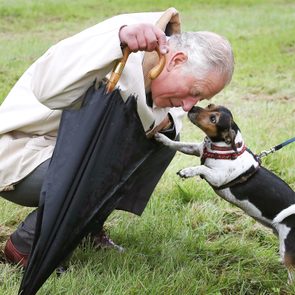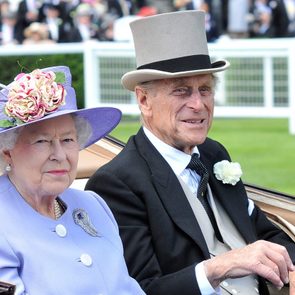King Charles’s Coronation: The Details and Traditions, Explained
Updated: Jun. 06, 2024

All eyes were on England for King Charles’s coronation—and not just across the pond. Just as millions of Americans watched the U.K.’s biggest royal weddings and Queen Elizabeth’s funeral, we did the same with this event. But most of us had a few more questions than our British friends about all the pomp and circumstance. Where did these traditions come from, and how were they adapted for a new monarch, the first to be crowned in Britain in 70 years?
“The coronation has traditional, religious and symbolic significance,” says royal expert Nicoletta Gullace, an associate professor of history at the University of New Hampshire who specializes in modern British history. “It is the moment the crown is placed upon the king’s head, and it signifies Charles’s authority in a long line of rulers ostensibly going back to the time of William the Conqueror in 1066.”
In addition to the ceremony itself, there were plenty of festivities—but not quite to the extent we’ve seen at other royal events, including Queen Elizabeth’s coronation back in 1953. “Charles wants to have a ‘slimmed-down monarchy,’ so he [was] trying to avoid the appearance of extravagance,” Gullace says. Still, no one does royal celebrations like the Brits, so the celebrations were filled with all the grandeur we’ve come to expect.
Let’s delve into what happened at King Charles III’s coronation, from the timeline of events to the history of the rituals and the crown jewels, as well as the snubs and drama. (Harry and Meghan, we’re looking at you!) Plus, find out who from the British royal family tree was there, what Queen Camilla’s coronation crown was like and whether King Charles III’s role in government changed after the big day.
Get Reader’s Digest’s Read Up newsletter for more royal-family insights, humor, cleaning, travel, tech and fun facts all week long.
When was King Charles’s coronation?
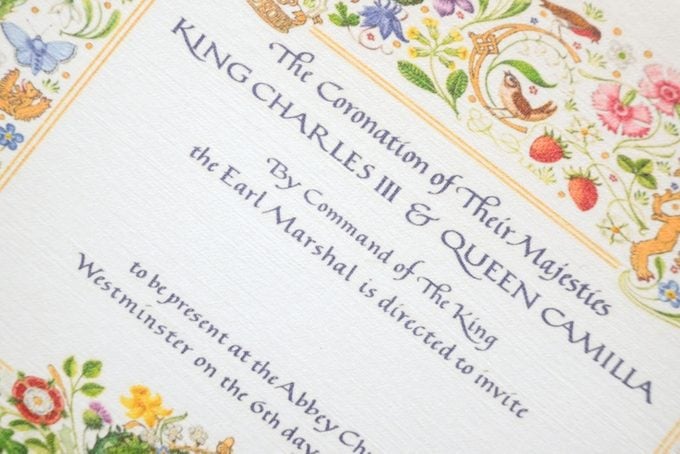
King Charles’s coronation date was Saturday, May 6, 2023. “Plans for the coronation of Charles III and his Queen Consort Camilla [were] underway for a long time under the code name Operation Golden Orb,” says historian and author Tony McMahon. The ceremony began at 11 a.m. London time.
How long did it take for Charles to be coronated? “The coronation was much shorter than the three-hour royal marathon Queen Elizabeth II endured,” McMahon says. “There’s clearly a sense that attention spans are not what they once were.” In the end, the ceremony lasted around an hour. The celebratory events, however, continued through Monday, May 8.
Interestingly, May 6 is also the birthday of Prince Harry’s son, Archie, who turned 4 years old that day. It is also the date that the late Princess Margaret (Queen Elizabeth’s sister) married Antony Armstrong-Jones, as well as the wedding anniversary of Camilla’s daughter, Laura.
Why did the royal family wait so long to have a coronation?
In case you were wondering, it doesn’t have anything to do with why people didn’t want Charles to become king. Rather, it’s a tradition that dates back centuries. “Shortly after the previous king or queen dies, the new monarch is proclaimed at St. James’s Palace and throughout the kingdom, but there is a gap between that event and the coronation,” McMahon says. “That doesn’t mean we are without a sovereign. The Latin phrase rex nunquam moritur applies in these circumstances, which broadly translates as ‘the king never dies.’ So, we have a monarch—it’s just that a crown has yet to be popped on their head.”
Queen Elizabeth’s coronation was 18 months after the death of her father, so the gap between Charles’s accession to the throne upon her death on Sept. 8, 2022, and his coronation wasn’t unusual or particularly long, McMahon says. In fact, it was quite a bit shorter, at just around eight months.
“The reason for a gap between the accession and coronation is the requirement for a period of respectful mourning, and on the more practical side, getting things organized for the big day,” McMahon says. “If anything, coronations have become bigger logistical nightmares [starting] in the 20th century. Getting guests to Westminster Abbey from all over the world was not a concern for a medieval monarch.” Queen Elizabeth’s coronation in 1953 was the first to be televised, which added considerations for cameras, lighting and audio.
Was the coronation televised?
Yes. Prince Philip, Queen Elizabeth’s husband, famously championed televising her coronation, and major royal events have been standard viewing ever since. In addition to the BBC in England, many cable-news and broadcast networks in the United States televised the event. That included ABC, CNN, Fox News and BBC America, and the U.K.’s Sky News broadcast live on its YouTube channel. To watch the ceremony live, viewers had to get up really early because of the time difference: 11 a.m. BST in England is 6 a.m. East Coast time in the United States.
But King Charles’s coronation didn’t come close to the recent royal weddings in terms of viewership numbers. A whopping 22.8 million U.S. viewers watched the wedding of Prince William and Kate Middleton in 2011—and Harry and Meghan’s wedding topped that, with 29.2 million Americans watching their nuptials in 2018. In contrast, Queen Elizabeth’s funeral drew only 11.4 million U.S. viewers.
King Charles III’s coronation ceremony drew low(ish) numbers as well—around 20 million viewers in the U.K. and 10 million in the United States. Before the event, Gullace predicted: “Given the Queen’s Platinum Jubilee last summer, her extremely long funeral event and all of Prince Harry’s Netflix specials and book talks, people may be royaled out.” King Charles also doesn’t have the same popularity as the younger royals or the late queen.
What happened at the coronation?
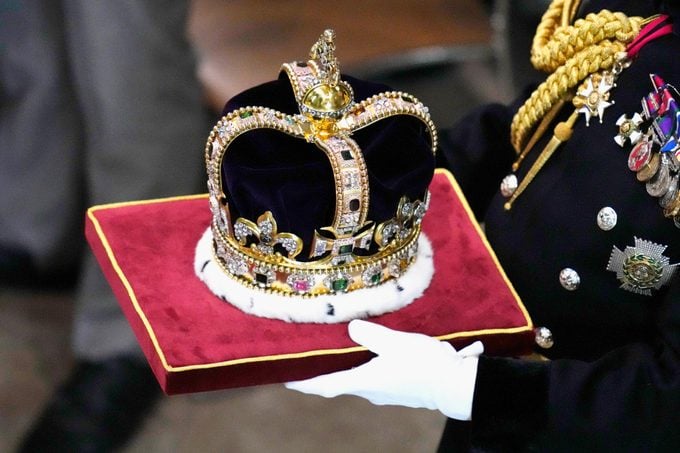
The coronation isn’t just a political event—it’s also a religious ceremony. “King Charles [was] literally being anointed as God’s chosen ruler,” McMahon says. “That may seem weird to us today in the 21st century, but it’s still what legitimizes having a monarch.” At the ceremony, Charles was affirmed as the head of the Church of England, and his power as the symbolic ruler of the realm was solidified, Gullace says. “It is a solemn occasion, but it is accompanied by a festive public holiday, a pop concert, a light show at Windsor Castle, extended pub hours and community luncheons,” she says. Here’s a full timeline of the events.
The procession to Westminster Abbey
Traveling from Buckingham Palace in the Diamond Jubilee State Coach, King Charles and Queen Consort Camilla processed to Westminster Abbey through central London for the King’s Procession. Westminster Abbey, by the way, also hosted Queen Elizabeth and Prince Philip’s wedding, Prince William and Kate Middleton’s wedding and the queen’s funeral—and it is the spot for royal coronations. “The first coronation at Westminster Abbey was in 1066, when William the Conqueror [who invaded England from Normandy] was crowned king,” says royal expert and author Marlene Koenig. “Charles [was] the 40th monarch crowned at the abbey.”
Fun fact: Only two monarchs since 1066 were not crowned—Edward V, who reigned for two months in 1483 before mysteriously vanishing, and Edward VIII, who abdicated in 1936. Having King Charles’s coronation here connected him with his ancestors through the ritual and the place where it was held, Gullace says.
The coronation ceremony
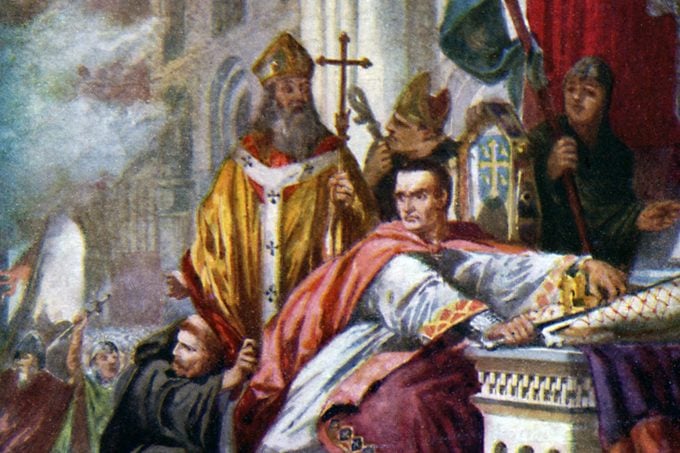
The ceremony itself has been largely the same since medieval times. “The service is defined in a medieval Latin manuscript called the Liber Regalis, basically a manual for a coronation, which is first and foremost a religious service,” Koenig says. The Archbishop of Canterbury, the head of the Church of England, anointed King Charles with holy oil, and he swore to uphold the Christian faith and the laws of England. The anointing took place behind a specially embroidered screen to signify the sanctity of the moment.
After taking the oath and being anointed, Charles was given the orb, coronation ring and scepter, which symbolize his divinely ordained role as king of the United Kingdom. He was then crowned—but not quite in the same way as the last king. “Back in 1937, the late Queen Elizabeth’s father King George VI was also crowned as Emperor of India, King of the Union of South Africa, the dominions of Canada and Australia, and all the colonies in the empire,” McMahon says. “Charles will be king of a lot less. He may be the last British head of state in some countries, like Australia, where sentiment is growing for a president.”
A representation of other faiths
This was a change from previous coronations. “King Charles III is the head of the Church of England, but he’s always been keen to position himself as a royal for all faiths,” McMahon continues. That’s why there were more representatives of faiths this time around, other than just the Church of England. Representatives from the Muslim, Hindu, Jewish, Sikh and Roman Catholic faiths all played a role in the coronation, and King Charles recited a new pledge written by the Archbishop of Canterbury that promised to protect all faiths under his rule.
Prince William’s tribute to the king

Only Prince William, as heir to the throne, paid homage to the king. None of the other royal dukes did this, even though it was a feature in previous coronations. “Charles scrapped this to avoid Andrew and Harry having a role in the coronation,” Koenig says.
However, the decision also excluded the other royal dukes, the Duke of Gloucester and the Duke of Kent, from paying homage. Prince Edward, Charles’s youngest brother, who was recently given the title Duke of Edinburgh, was also left out because of the new rule.
What did paying homage entail? William kneeled in front of his father, held his hands and said, “I, William, Prince of Wales, pledge my loyalty to you and faith and truth I will bear unto you, as your liege man of life and limb. So help me God.” He then kissed his father on the cheek before heading back to the pew to sit with his wife and children.
Prince George’s special role
Prince William’s 9-year-old son George, who is second in line to the throne after his father, made history with his role in the ceremony as a Page of Honour to King Charles. This was his first official engagement, according to McMahon. His duties included processing down the nave of Westminster Abbey and helping to carry the king’s robes. Normally, young children, let alone a future monarch, aren’t part of the ceremony in this way, so this was a bit of a departure from tradition. The king’s other three pages were Master Nicholas Barclay, the grandson of one of Camilla’s companions; Master Ralph Tollemache, the son of Charles’s godson; and Lord Oliver Cholmondeley, the son of a lord-in-waiting to the king.
Camilla’s anointing

Camilla, queen consort, was also anointed with holy oil and crowned. Interestingly, only female consorts are crowned at coronations, not male consorts. “We are used to the image of Queen Elizabeth II sitting alone in 1953 while Prince Philip watched, but this coronation will see two crownings, not just one,” McMahon explains. Camilla was crowned in a similar way to the queen mother in 1937, when she sat alongside King George VI.
Although public sentiment has shifted in Camilla’s favor over the last few decades, since the death of Charles’s first wife, Princess Diana, experts weren’t sure if Charles would officially drop the word consort from Camilla’s royal title, making her queen of the realm. Since Charles didn’t marry Camilla first and she is a second wife, she didn’t automatically receive that title. But the official invitation to the coronation didn’t include the word consort, styling her as “Queen Camilla,” and this was indeed an indication of things to come. Shortly before the big day, this change was also made on the royal family’s official website.
Camilla’s family members also had roles in the ceremony. Her grandsons, Masters Gus Lopes, Louis Lopes and Freddy Parker Bowles, as well as her great-nephew Master Arthur Elliot, were her four Pages of Honour and attended to her throughout the ceremony. In addition, her two children and son-in-law had prominent seating.
The procession to Buckingham Palace
The coronation was followed by a procession back to Buckingham Palace. Called the Coronation Procession, this ceremonial parade was a larger event than the one that brought Charles and Camilla to the abbey. The king and queen rode in the Gold State Coach, which was made in 1760 and has been used at every coronation since William IV’s in 1831. The newly crowned couple was accompanied by members of the armed forces and also joined by other members of the royal family.
The balcony appearance

And finally, the grand finale: the obligatory balcony appearance and lots of waving to the adoring crowds below. The big question before the event, of course, was: Who would be on the balcony? Since Charles had made no secret of his desire to streamline the monarchy, experts speculated that only the working royals might join the king and queen, as with the Queen’s Jubilee in 2022. In the end, that was pretty accurate. The final group included Prince William, Princess Kate and their children (Prince George, Princess Charlotte and Prince Louis), as well as Princess Anne, Prince Edward, Duchess Sophie, the Earl of Wessex, Lady Louise, the Pages of Honor and Camilla’s ladies-in-attendance.
What about Harry? The Duke of Sussex attended the ceremony (more on that later), but he did not appear on the balcony, since he is no longer a working royal. Prince Andrew, who has been plagued by scandals in recent years and was stripped of his royal patronages and military titles in 2022, also didn’t make the cut.
Coronation weekend
The fun didn’t end there! If Saturday marked the formal, solemn occasion, Sunday was the day to party. “On Sunday, May 7, there [was] a dazzling coronation concert at Windsor Castle with big-name rock, pop and music stars,” McMahon says. The concert led up to “Lighting Up the Nation,” which featured illuminated famous locations around the U.K. As was the case with the late queen’s jubilees, there were a plethora of laser and drone displays, which are fast becoming a hallmark of major royal occasions, McMahon says. Plus, there were the more traditional fireworks and military bands crashing cymbals, banging drums and playing bagpipes.
Throughout the weekend, people also organized street parties called Coronation Big Lunches in their communities to connect with their neighbors and partake in the revelry. In part to facilitate this, Monday, May 8, was a holiday in the U.K. “In addition, people [were] encouraged to do good deeds in their communities, described as ‘Big Help Out’ activities,” McMahon says. “The idea was to make the coronation something more community-focused as opposed to a display of aristocratic baubles.”
What royal traditions did King Charles’s coronation incorporate?
All the royal coronation regalia hold special significance. These items are used to display the longevity of the ritual, Gullace explains. “The big day [saw] the coronation regalia brought out of the glass cases and put to their intended use, instead of being gawped at by tourists in the Tower of London,” McMahon says. And while it wasn’t part of the royal coronation traditions, King Charles wore the ring on his pinky that he always wears.
The coronation chair

King Charles didn’t sit on the actual throne until after he was crowned. For most of the ceremony, he was perched on this 700-year-old wooden chair. Made for King Edward I in 1296, it is normally kept at Windsor Castle’s St. George’s Chapel. The chair originally contained the legendary Stone of Scone, a large rock that was seized from Scotland. “In 1996, the government agreed to return the stone to Scotland,” Koenig says. “The agreement to return the Stone of Scone more than 700 years after it was taken by Edward I included the proviso that it would be brought to London for the coronation of a monarch.” The stone was reunited with the chair for King Charles’s coronation, for the first time since 1996.
The crown
King Charles wore the same crown that the queen did at her coronation. Only used at the actual moment of crowning, St. Edward’s Crown is a “copy” made in 1661 for King Charles II, as the earlier medieval crown was destroyed when the monarchy was briefly overthrown by a rebellion led by Oliver Cromwell in the 17th century. Made of gold and set with gemstones including rubies, sapphires and amethysts, King Charles’s coronation crown weighs in at a whopping five pounds.
According to Koenig, Charles III was the seventh monarch to wear it, and his coronation was the only time he will ever wear it. For the rest of the service, he wore the Imperial State Crown, which was made for King George VI’s coronation and last seen on Queen Elizabeth II’s casket.
The coronation spoon
This medieval utensil isn’t something the king ate with! “The coronation spoon is the oldest crown jewel, as it survived Cromwell’s destruction of royal regalia,” McMahon says. Luckily, it was sold instead of being melted down with all the other royal gold. “It dates back to the 12th century and is used to anoint the king with holy oil—the most sacred part of the whole ceremony.” The spoon is the only piece of royal goldsmith’s work still in existence from the 12th century; it was later set with pearls when it was returned to the monarchy, post-Cromwell.
The orb and scepter
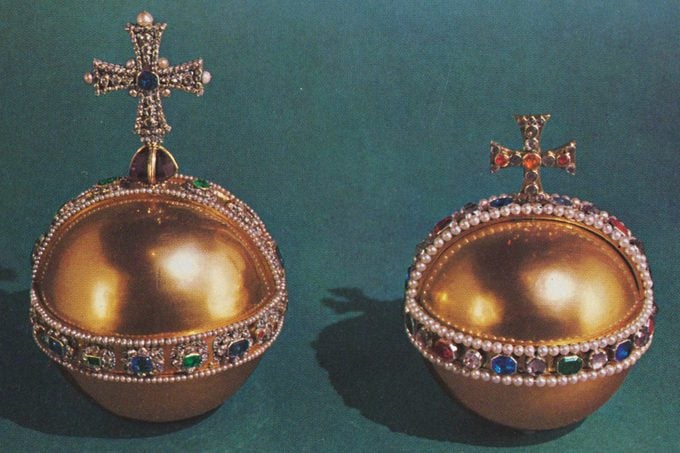
These items represent the sovereignty of the monarch, and both date from 1661, like St. Edward’s Crown. “The scepter is a magnificent piece of bling that includes the largest colorless cut diamond in the world, one of several king-sized diamonds cut from the mega Cullinan Diamond discovered in 1905 in present-day South Africa,” McMahon says. The diamond was added to the scepter in 1911. Representing the Christian world, the orb was held by the monarch in his right hand. Topped with a cross, it contains diamonds, rubies, emeralds, sapphires and pearls.
Camilla’s crown
“Camilla is the first consort in several centuries to not have a new crown for the coronation,” Koenig says. “She [wore] Queen Mary’s coronation crown, the consort of George V, Charles’s great-grandparents.” Created for the 1911 coronation, the crown was altered somewhat for Camilla. Three of the Cullinan diamonds were inserted and some of the crown’s arches were removed to create a different look.
Notably, the revised crown left out another stone that was in the original 1911 version: the supposedly cursed Koh-i-Nur Diamond, which was taken from India in 1849 and seen as a symbol of conquest. This was an attempt by Charles and Camilla to distance themselves from the British monarchy’s history of colonialism. However, the Cullinan Diamond is not without its own controversy: It was a “gift” from South Africa, another former British colony.
The coronation emblem
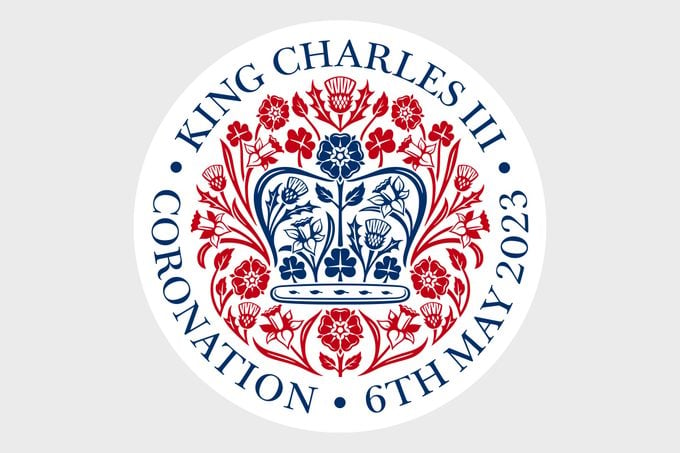
Charles had a new emblem for his coronation, which was used on flags, online materials and other branded merchandise for the event. Created by British designer Sir Jony Ive, the emblem represented Charles’s longstanding love of nature and conservation, and incorporated the British symbols of St. Edward’s Crown and the Union Jack flag’s red, white and blue color scheme. Using illustrations of flowers from the four nations of the United Kingdom, the emblem featured the rose of England, the thistle of Scotland, the daffodil of Wales and the shamrock of Northern Ireland.
The coronation invitation
The lucky invitees to the ceremony received a whimsical card (made of recycled material with gold foil details) decorated with images of wildflowers and other symbols of nature, along with Charles and Camilla’s Coats of Arms. Created by Andrew Jamieson, an artist whose work is inspired by the medieval legends of King Arthur, the original design was hand-painted in watercolor and also features the Green Man of British folklore, who symbolizes spring and rebirth. As mentioned, the invitation dropped consort from the queen’s title, simply naming Charles’s wife as Queen Camilla.
The official coronation dish
Queen Elizabeth had Coronation Chicken, but King Charles had Coronation … Quiche? Following tradition, a recipe was released for the event’s signature dish, but it surprisingly cooked up a bit of controversy. “Quiche is potentially a stormy political choice in post-Brexit Britain [because] its origin is very much in France and possibly Germany—not what one might call a traditional English meal,” McMahon says. Although Coronation Chicken became a successful staple in the U.K., “it’s unlikely that the Coronation Quiche of 2023 will have that kind of impact.”
The Coronation Quiche also rather unusually includes beans, which raised some eyebrows. “It’s a vegetarian dish that can be adapted to modern dietary preferences,” McMahon says. “Some have claimed it is a budget dish tailored to a Britain where families are feeling the economic pinch.” The price of eggs notwithstanding, “opting for something more haute cuisine would have shown a king out of touch with his people.”
The pomp and circumstance
Although the coronation has followed the same basic ceremony for a thousand years, the grandeur we associate with the event is a relatively recent tradition. “The type of grandiose public pageantry and national holiday we enjoy today dates back to the late 19th century,” Gullace says. “At this time, the palace became adept at putting on magnificent public spectacles to enhance the prestige of the crown.”
Who performed at the coronation?
During the ceremony itself on May 6, the music featured 12 new orchestral, choral and organ pieces commissioned for the event—including the coronation anthem from famed Broadway composer Andrew Lloyd Webber. There was also a bit of Greek Orthodox music, a tribute to Charles’s father, Prince Philip, who was born in Greece.
The party really got started, though, with a pop concert the next day at Windsor Castle, which was broadcast on the BBC; 5,000 pairs of tickets were also released to the public and drawn by lottery. Charles reportedly had issues securing entertainers for the event, with Adele, Harry Styles, Ed Sheeran and the Spice Girls all declining the palace’s request to perform. Some of the artists said they had conflicts or were on tour, but several top choices, including Adele, were reported not to have gigs that day, Gullace notes.
Thankfully, a few big acts with ties to the monarchy came through for the king: Katy Perry and Lionel Richie, two Americans connected to Charles through their work with his charities, as well as opera singer Andrea Bocelli, pop star Nicole Scherzinger, British group Take That and U.K. performers Sir Bryn Terfel, Freya Ridings and Alexis Ffrench. Plus, an eclectic lineup of stars made appearances in prerecorded segments, including Tom Cruise, Joan Collins, Tom Jones, Bear Grylls and Winnie the Pooh. The event was hosted by Downton Abbey and Paddington actor Hugh Bonneville.
In addition to famous musicians, there was also a performance by the Coronation Choir, “created from community groups and amateur singers reflecting the U.K.’s diverse population,” McMahon says. The choral group included refugee choirs, LGBTQ+ singers and deaf signing choirs.
Who attended the royal coronation?

An astonishing 8,000 people attended Queen Elizabeth’s coronation—even though Westminster Abbey seats only about 2,200 people. Extra grandstands with tiered seating needed to be built to fit everyone. But that wasn’t the case for Charles, who kept costs top of mind. “This time, the numbers [were] kept down to around 2,000—so no massive building work for this coronation,” McMahon says. So who snagged a seat?
Heads of state
The ceremony was attended by nobility, heads of state, eminent clergy and a smattering of ordinary Britons who contributed in exceptional ways to British well-being, such as nurses, military personnel and activists promoting causes dear to Charles. Heads of state from France, Poland, Australia, New Zealand, Germany and many more were there. British Prime Minister Rishi Sunak also attended, as well as the seven living past PMs.
The royalty of Europe—and the world—also showed up, including the royal houses of Norway, Sweden, Denmark, the Netherlands, Belgium, Spain, Luxembourg and Japan. “Prince Albert and Princess Charlene of Monaco were the first Euro-royals to RSVP,” McMahon says. Political leaders of other Commonwealth nations (which used to be ruled by Britain)—including Nigeria, Bangladesh, Malta and the Bahamas—attended too.
A few lucky citizens
Did any regular people get to attend the coronation? Yes—but only those with special circumstances. “Up until the start of February 2023, members of the public were invited to apply to be at the coronation if they could prove that a relative had taken part in a previous coronation. This is an ancient, 700-year-old tradition,” McMahon says. “They were told to apply to the newly created Coronation Claims Office. Back in 1953, a body called the Court of Claims considered similar requests.” The office upheld the claim of lucky commoner Francis Dymoke, a farmer whose family has been involved in coronations since the Middle Ages, to be the “King’s Champion” and carry the flag of the Royal Standard.
More “ordinary” people in attendance included 450 British Empire Medal recipients, who were awarded for outstanding community and charity work. And an additional 400-plus young people involved with some of the king and queen’s charities, such as the Prince’s Trust, also had a special viewing from St. Margaret’s Church at Westminster Abbey.
The royal family
Of course, the various members of the royal family, including Queen Elizabeth’s grandchildren, were there, and it was incredibly important for the monarchy to present a strong, unified front. As the next in line to the throne, Prince William was front and center in the audience, and as noted earlier, he was also part of the ceremony.
Did Prince Harry and Meghan Markle attend King Charles’s coronation?

This, of course, was the big question leading up to King Charles’s coronation. “They’ve hardly endeared themselves to the royal family,” McMahon says, referencing the couple’s recent Netflix series and Harry’s tell-all memoir, Spare, which were both critical of Harry’s family and the institution of the monarchy. But the Duke and Duchess of Sussex did receive a formal invitation. In mid-April, however, the couple announced that Harry would attend alone, while Meghan stayed at home in California with their children, the newly titled Prince Archie and Princess Lilibet.
Was Harry’s appearance an effort at patching things up? “It’s difficult to see Harry’s attendance as an attempt at reconciliation when he was still dropping bombshell claims about his father days before the big event,” McMahon says, referring to a court case about alleged phone hacking by the tabloid press, in which Harry once again didn’t present his father and brother in a good light.
As for Meghan, many reasons were speculated for her absence, including Archie’s birthday, but most likely, she just wanted to avoid the circus altogether. “If she was there, her every expression and gesture would be scrutinized,” McMahon says, “so on balance, better for her to stay away.”
Whether they attended or not, though, they still stole the limelight on Charles’s big day. “This kind of once-in-a-lifetime event should be the stuff of royal legend, as the coronation of Queen Elizabeth II was for decades,” McMahon says. “Instead, all people are going to remember is an unseemly spat between King Charles, his younger son and daughter-in-law. It sets a bad tone for this reign.”
Who didn’t attend the royal coronation?
Missing royals and nobility
In addition to Meghan’s notable absence, the limited seating meant that some of Britain’s nobility was excluded from the ceremony guest list. “Not all members of the aristocracy were invited,” Gullace says, “and those who were not [likely felt] snubbed.” Plus, it was reported that fewer than 100 members of Parliament (out of 650!) were invited—and only the prime minister was allowed to bring a plus one—which caused a stir among the government.
Ex-royal Sarah Ferguson, the former wife of Prince Andrew, didn’t even score an invite, although she said on Good Morning Britain that she understood the snub. “It is a state occasion, and being divorced, I don’t think you can have it both ways,” she said. “You’re either in or out.” Ferguson did, however, attend the coronation concert in the VIP section.
President Joe Biden
The White House confirmed that U.S. President Joe Biden wouldn’t attend the coronation, but First Lady Jill Biden was there to represent the country. (In fact, she brought along one of her granddaughters, 24-year-old Finnegan Biden.) The president did speak with Charles ahead of time to congratulate him, though, and expressed his interest in a future visit to the U.K. to meet with the king. Although no direct reason was given for Biden’s absence, some have pointed out that Biden was following precedent, as no U.S. president has ever attended a coronation. (However, the last one was 70 years ago, when transatlantic travel was a bit more cumbersome.) There were also rumors that because of Biden’s Irish heritage, he wasn’t supportive of the British monarchy, but the White House insisted his absence wasn’t a snub.
Also, as was the case with the queen’s funeral, no former U.S. presidents were invited to the coronation—not surprising, given the trimmed-down guest list.
What happened after the coronation?
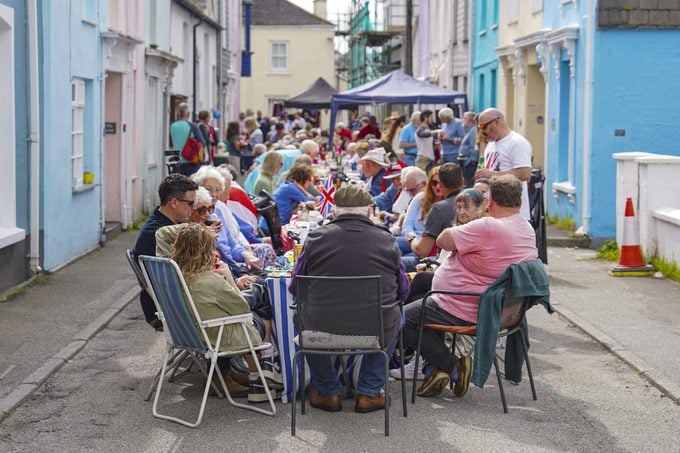
After the coronation and the celebratory concert the next day, there was a bank holiday on Monday, with the option to get involved in parades, street parties and other celebratory events. Some simply chose to have a nice day off. A bank holiday is basically a national holiday in which banks and businesses are closed, and this one was basically seen as a treat from the new king to his people.
But what about the new monarch and his family: Did King Charles’s role change in any way? No, according to Koenig. The coronation was simply a formal service where the king and queen are crowned. But plans have already been put in place to shore up the roles and importance of working members of “The Firm,” including Prince Edward, Princess Anne, Princess Catherine and Prince William.
Plus, Charles will try to be a “modern” monarch, pursuing serious public service and causes such as environmental conservation. He’ll want to be seen as useful, practical and restrained, so he’s unlikely to have any other flashy events like the coronation anytime soon. “Charles will be 75 in November and could have a service of thanksgiving, but with the coronation in the same year, perhaps not,” Koenig says. “Apart from state dinners and the annual Trooping the Colour ceremonies, there will be no other event similar to the coronation.”
Due to his probable short reign, he’s unlikely to leave the same mark as Queen Elizabeth’s legacy. But he’ll want to be remembered as the king who successfully transferred the monarchy to the next generation of the 21st century and beyond.
About the experts
- Nicoletta Gullace is a British historian, an expert on the royal family and an associate professor of history at the University of New Hampshire.
- Tony McMahon is a historian and author who often discusses the royals and royal scandals.
- Marlene Koenig is a royal expert and writer. She is the author of Queen Victoria’s Descendants and has appeared on a wide range of media outlets, from CNN and NBC to the BBC.
Sources:
- Royal.uk: “The Coronation of The King and The Queen Consort”
- The National Archives: “Coronation of Their Majesties The King & Queen Camilla”
- Royal Collection Trust: “The Crown Jewels: Coronation Regalia”
- Royal Collection Trust: “The Coronation Spoon”
- Westminster Abbey: “The Coronation Chair”
- Gov.uk: “Coronation Claims Office to look at historic and ceremonial roles for King Charles III’s Coronation”



















